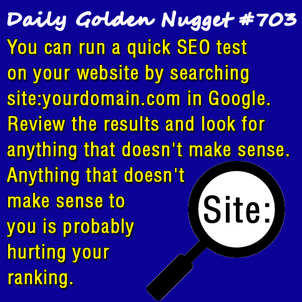 Search engines do not like low value websites. Low value sites typically include those with 250 words or less on a page, and those that appear to have duplicate content. Does Google think your site is low value? Do you even know?
Search engines do not like low value websites. Low value sites typically include those with 250 words or less on a page, and those that appear to have duplicate content. Does Google think your site is low value? Do you even know?Navigate over to Google search and search for "site:yourwebsite.com." (Meaning your actual website address, not the words "yourwebsite.com") Don't include the quotes, DO NOT put a space between the "site:" and your domain name.
The results of this search will show you all the pages Google is aware of, but not necessarily how many Google is willing to show in the search results. A quick examination of these results will give you valuable insights into the overall performance of your site in the SERPs.
Here's what you need to look for as you browse through the results from that search:
1. What order did the pages appear in? The order of the pages indicates what Google thinks is most important to you. The first 10 results should include pages that would directly bring people to products or services you sell.
If any of the first 10 pages include your privacy policy, terms of service, or other "fluff" pages then you need to have a talk with your SEO professional.
2. Read the descriptions of each result in the first 4 or 5 pages. If the descriptions are terse or repetitive then they need to be fixed.
Every page on your website should have a unique description appearing in these test search results. The only way to guarantee this is by manually writing a meta description for each of your pages. Those terse results usually indicate random guessing by Google.
3. Look for repetitive or very similar content. Sometimes Google views pages are nearly duplicate and low quality even though you never intended it that way. Sometimes this happens when your website uses URL variables to display different variations of the same page.
Track all the pages with similar page titles and descriptions then give that list to your SEO professional and website programmer for review and improvement.
4. Look for pages that show your footer information as the description of the page. Typical website footers include contact information and copyright notices. Results like this are a perfect way to find your web pages that Google doesn't understand, or can't read. Reprogram and correct any page that shows the footer information as the page description.
5. Look for obvious problems. If you see anything that doesn't make sense then you simply need to contact your SEO professional or your website programmer to fix it. This includes any page where you might say to yourself "what is that and why is that there?"
6. Count the number of pages that Google reports back. Any small website where Google reports a ridiculously large number of pages indicates a serious programming problem. Inversely, a different type of programming problem exists if you have 1000 products on your website but Google report only a few hundred known pages.
These 6 items won't turn you into a professional Search Engine Optimization Analyst, but they will help you understand what areas of your website need help. It's also good to cross reference this type of test on your own so you can spot-check the SEO work others are doing for you.








